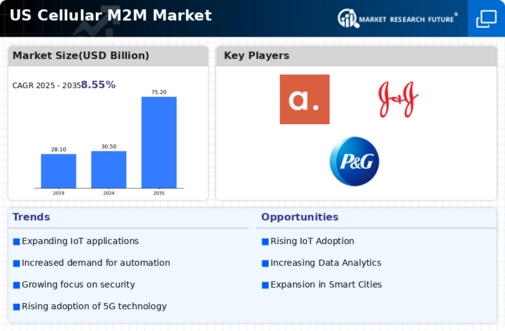Government Initiatives and Funding
Government initiatives and funding play a crucial role in the advancement of the cellular m2m market. Various federal and state programs are designed to promote the adoption of m2m technologies, particularly in sectors such as transportation, energy, and public safety. For instance, initiatives aimed at enhancing smart city infrastructure often include funding for m2m solutions that improve traffic management and energy efficiency. The U.S. government has allocated substantial resources to support these initiatives, with investments reaching upwards of $1 billion in recent years. Such funding not only accelerates the deployment of cellular m2m technologies but also encourages private sector participation, fostering innovation and competition within the market. As these initiatives continue to evolve, they are likely to create a more conducive environment for the growth of the cellular m2m market.
Advancements in Device Connectivity
Advancements in device connectivity are significantly influencing the cellular m2m market. The proliferation of connected devices, driven by the Internet of Things (IoT), is creating new opportunities for m2m applications across various sectors. Enhanced connectivity options, such as low-power wide-area networks (LPWAN) and improved cellular technologies, are enabling devices to communicate more efficiently and effectively. This is particularly relevant in industries like agriculture, where sensors can transmit data over long distances with minimal power consumption. The cellular m2m market is expected to benefit from these advancements, with forecasts suggesting that the number of connected devices could reach over 50 billion by 2030. Such growth indicates a robust demand for m2m solutions that can support this expanding ecosystem, further propelling the cellular m2m market.
Rising Demand for Remote Monitoring
The cellular m2m market is experiencing a notable surge in demand for remote monitoring solutions across various sectors, including healthcare, agriculture, and transportation. This trend is driven by the need for real-time data collection and analysis, which enhances operational efficiency and decision-making. For instance, the healthcare sector utilizes cellular m2m technology to monitor patients remotely, reducing hospital visits and improving patient outcomes. In agriculture, farmers leverage these solutions to monitor soil conditions and crop health, leading to increased yields. The market for remote monitoring solutions is projected to grow at a CAGR of approximately 25% over the next five years, indicating a robust expansion in the cellular m2m market. This rising demand is likely to propel investments in cellular m2m technologies, further solidifying their role in various industries.
Integration of Artificial Intelligence
The integration of artificial intelligence (AI) into cellular m2m applications is transforming the landscape of the market. AI enhances the capabilities of m2m devices by enabling predictive analytics, automated decision-making, and improved data processing. This integration allows businesses to optimize operations, reduce costs, and enhance customer experiences. For example, AI-driven analytics can predict equipment failures in manufacturing, allowing for proactive maintenance and minimizing downtime. The cellular m2m market is expected to witness a significant increase in AI adoption, with estimates suggesting that AI-enabled m2m solutions could account for over 30% of the market by 2027. This trend indicates a shift towards smarter, more efficient systems that leverage data-driven insights, thereby driving growth in the cellular m2m market.
Growing Need for Supply Chain Optimization
The cellular m2m market is increasingly driven by the growing need for supply chain optimization across various industries. Companies are recognizing the importance of real-time tracking and monitoring of goods to enhance efficiency and reduce costs. Cellular m2m solutions enable businesses to gain visibility into their supply chains, facilitating better inventory management and logistics planning. For example, retailers utilize m2m technology to track shipments and manage stock levels, leading to improved customer satisfaction and reduced operational costs. The market for supply chain optimization solutions is projected to grow significantly, with estimates indicating a potential increase of 20% in adoption rates over the next few years. This trend underscores the critical role of cellular m2m technologies in streamlining operations and enhancing competitiveness in the market.

















Leave a Comment